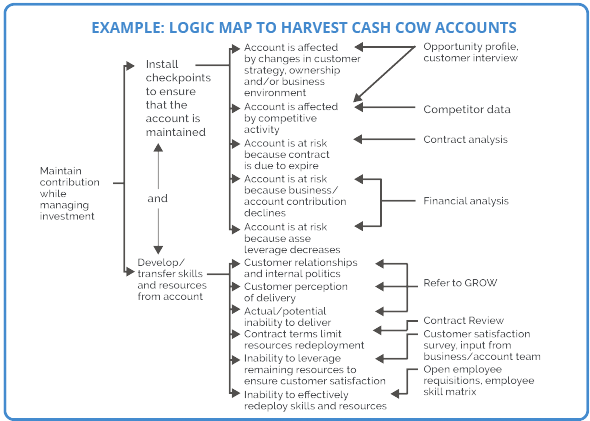Strategic account management
A global high tech company was facing the complex challenge of managing a large portfolio of accounts in the midst of revenue slow down and decreasing profitability. Several issues plagued the portfolio:
- The company was present in many industry verticals, with accounts operating in silos
- Share of spend at key accounts was decreasing
- Too many accounts were designated as “strategic”
- Many accounts that were failing to meet target objectives were viewed as “key”, receiving price discounts
- Large accounts, not necessarily the most profitable, were awarded substantial resources at the expense of small, growing accounts with the highest up-side potential
- Customer defections were putting revenues at risk
The objective was to reverse revenue slow down, halt customer defections, and restore profitability.
We established strategic account management to maximize the value of the portfolio.
Short Term: Year 1
- Divested accounts on the order of $75 million
- Maintained revenue base
- Stopped customer defections
- Increased portfolio profitability by $8 million
Medium Term: Year 2
- Grew revenue by 2%
- Started to gain share of spend at key accounts
- Improved portfolio profitability by $28 million, representing a portfolio margin improvement of 2%
Established strategic account management phased in three steps:
1. STRATEGIC REVIEW
For each account, analyzed attractiveness and performance
- Account Attractiveness
- Opportunity for Profitable Growth
- Revenue growth potential
- Profit potential
- Strategic fit (alignment with corporate objectives)
- Alignment of value proposition to the business strategy
- Customer market position in its industry
- Customer segment (level of priority for the company)
- Competitive position (advantage or disadvantage) within customer account
- Opportunity for Profitable Growth
- Account Performance
- Current revenue and profitability
- Adequacy of resources
- Share of spend
- Customer satisfaction
Segmented accounts based on their attractiveness and performance
- Future Star Accounts: High attractiveness and low performance
- Strategic Accounts: High attractiveness and high performance
- Cash Cow Accounts: Medium attractiveness (limited growth opportunity, high strategic fit) and high performance
- Streamline Accounts: Medium attractiveness (limited growth opportunity or low strategic fit) and low performance
2. TARGET SETTING
Set targets by account based on the portfolio categorization
- Targets for “Future Star Accounts”
- Focus on improving account performance and invest resource selectively
- Identify means to improve share of spend: improve service mix, extend price discounts, improve customer service, leverage competitive advantage
- Targets for “Strategic Accounts”
- Set growth rate objectives based on available growth space, sustainable growth
- Increase volume of existing offerings, expand the mix of services, invest resources
- Targets for “Cash Cow Accounts”
- Focus on protecting position, maintaining value creation
- Transfer skill and resources to other accounts (i.e. “Future Star Accounts” and “Strategic Account”)
- Targets for “Streamline Accounts”
- Decide when to exit: immediately, at contract term, over time
- Manage for cash

3. ACCOUNT IMPLEMENTATION PLAN
Established an account plan structure
Tasked each account manager to produce a business plan against given target objectives to include
- quick targeted initiatives
- resource use
- work plan, including quarterly milestones
Installed measures and KPIs
Set regular performance reporting



